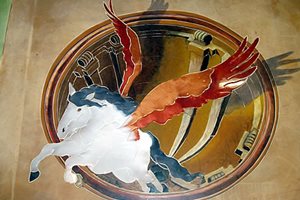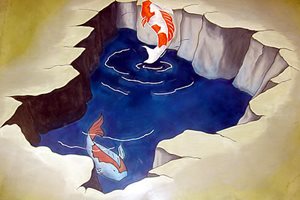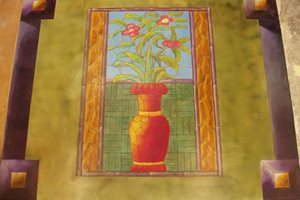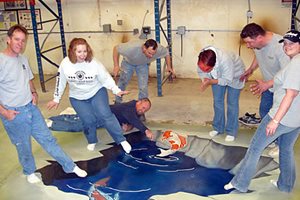- Staining Concrete
- Stamped Concrete
- Concrete Overlays
- Concrete Resurfacing
- Concrete Polishing
- Concrete Dyes
- Colored Concrete
- Indoor Concrete
- Concrete Floors
- Concrete Countertops
- Garage Floor Coatings
- Furniture, Sinks, Fire Bowls
- Basement Floors
- Outdoor Concrete
- Concrete Patios
- Concrete Driveways
- Concrete Pool Decks
- Outdoor Kitchens & Counters
- Outdoor Fireplace
- Concrete Walkways
- Concrete Pavers
- Concrete Walls
- Repair & Maintenance
- Foundation Repair
- Concrete Crack Repair
- Concrete Sealers
- Building with Concrete
- Concrete Homes
- Concrete Basements
- Decorative Concrete
- Fire Resistant
Illusions on Concrete
Concrete expert and well-known artist collaborate to create 3-D decorative concrete
Bob Harris has always been on the cutting edge of new developments in the decorative concrete industry. Whether its through his time spent researching and testing new products, training students to stamp, stain and overlay concrete, or his speaking engagements across the world, he's witnessed and even helped develop some of the newest and most innovative techniques being used on concrete today. With his eye always open to new ideas and methods, Harris couldn't help but be intrigued by street painting, as he observed artists creating extraordinary murals on sidewalks, streets and plazas using chalk and other biodegradable products. The phenomenal works of art amaze passersby, but are only temporary and quickly vanish with the next rain or street cleaning.
Admiring the art and discouraged by its brief existence, Harris decided these masterpieces ought to be made permanent in concrete. He quickly went to work on what he does best - researching and developing a new process he could practice on concrete. His first step was to find one of these talented street artists. Passionate about trompe l'oeil murals, Harris search led him to Julie Kirk, an art professor at Irvine Valley College in Irvine, Calif., and a renowned street-painting artist with an eye for creating stunningly realistic three-dimensional art.
After a few brief phone calls with Harris, Kirk was as eager as he was to try creating imperishable works of art on concrete. They agreed to conduct a joint training class at Harris Decorative Concrete Institute training center. Hence, the first-ever Illusional Concrete Art Workshop evolved.
Creating illusional art begins by choosing a piece of artwork and transferring the design to a concrete surface. During the training class, students are taught layout techniques, such as gridding, and using an overhead for projecting the art onto concrete. The image is then traced with chalk.
Kirk taught the students how to utilize single-point perspective, the simplest method for creating objects that look three-dimensional. From a single point of view, all lines move away from the viewer, converging to what is called a vanishing point. Drawing in this fashion creates the illusion of depth and dimension from the viewers standpoint, which means the artwork projects an accurate 3-D perspective even when viewed from different angles.
The images were colored using the Decorative Concrete Institutes water-based dyes and Rustoleum's new concrete stain. On the image of the winged horse, metallic epoxy coatings from Key Resin were also used. Kirk taught students a variety of faux finishing techniques, including creating a light source to reflect shadows and how to use proper shading to give the images greater realism.
The three-day Illusional Concrete Art Workshop generated overwhelming response, attracting both street artists and decorative concrete contractors. Because of the interest, Harris and Kirk have scheduled a second workshop that will cover advanced techniques, ranging from color theory to two- and three-point perspectives.
Harris is especially excited about the second workshop because it will also cover anamorphic perspective"a 3-D illusion that at face-value appears distorted, but when looked at from a different angle appears in normal proportions. Leonardo Da Vinci was the first known artist to experiment with the technique.
The second Illusional Concrete Art Workshop will be extended to four days, and will take place November 13-16, 2006, at the Decorative Concrete Institute in Douglasville, Ga. Register online at www.decorativeconcreteinstitute.com or call 770-489-4787.








